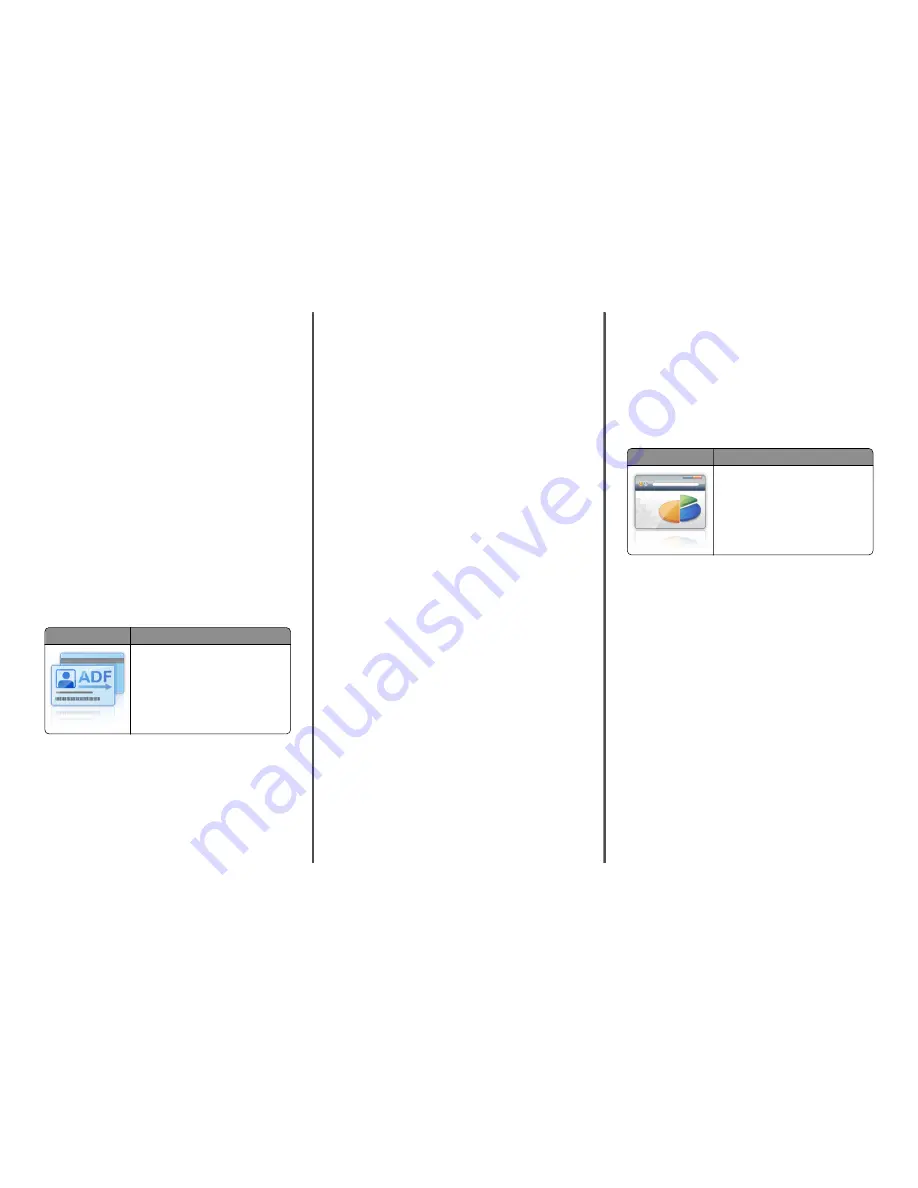
5
Click
OK
>
Apply
.
To use the application, touch
Scan to Network
on the scanner home
screen, and then follow the instructions on the scanner display.
Setting up Remote Operator Panel
This application shows the scanner control panel on your computer
screen and lets you interact with the scanner control panel, even when
you are not physically near the network scanner. From your computer
screen, you can view the scanner status, release held print jobs, create
bookmarks, and do other print-related tasks you might normally do
while standing at the network scanner.
1
Open a Web browser, and then type the scanner IP address in the
address field.
Note:
View the scanner IP address on the scanner home screen.
The IP address appears as four sets of numbers separated by
periods, such as 123.123.123.123.
2
Click
Settings
>
Remote Operator Panel Settings
.
3
Select the
Enabled
check box, and then customize the settings.
4
Click
Submit
.
To use the application, click
Remote Operator Panel
>
Launch VNC
Applet
.
Setting up ADF Card Copy
Use
To
Quickly and easily copy insurance,
identification, and other wallet
‑
size cards
using the Automatic Document Feeder (ADF).
You can scan and print both sides of a card on
a single page, saving paper and showing the
information on the card in a more convenient
manner.
1
Open a Web browser, and then type the scanner IP address in the
address field.
Note:
View the scanner IP address on the scanner home screen.
The IP address appears as four sets of numbers separated by
periods, such as 123.123.123.123.
2
Click
Settings
>
Apps
>
Apps Management
>
ADF Card Copy
.
3
Change the default output options, if necessary.
Selecting output options
•
Print Output
—Select this option to print the scanned card.
•
E
‑
mail Output
—Select this option to send the scanned card as
an e
‑
mail attachment.
•
Network Share Output
—Select this option to save the scanned
card to a shared folder on the network.
•
Scan File Format
—Specify the output format (TIFF, JPEG, or
PDF) of the scanned card.
Configuring e
‑
mail setting
•
Default e-mail address
—Specify the destination e
‑
mail address
for the scanned card. Use a comma to separate multiple e
‑
addresses.
Configuring network destination settings
•
Destination Server Address
—Type the server name or IP
address of the shared network folder, with the format
\\server
\share
.
•
Domain (Optional)
—Type the Windows domain for the
destination if the destination resides within a different
Windows domain than the printer.
•
Username
—Type the default user name to connect to the
destination.
•
Password
—Type the default password to connect to the
destination.
•
Authentication Type
—Select how users are authenticated
when connecting to the destination.
•
Append Timestamp
—Select the check box to add a time stamp
to the file name.
4
Change the default scanning options, if necessary.
•
Default tray
—Select the default tray to be used for printing
scan images.
•
Default number of copies
—Specify the number of copies that
should automatically print when the application is used.
•
Default contrast setting
—Specify a setting to increase or
decrease the level of contrast when a copy of the scanned card
is printed. Select
Best for Content
if you want the scanner to
adjust the contrast automatically.
•
Default scale setting
—Set the size of the scanned card when
printed. The default setting is 100% (full size).
•
Resolution setting
—Adjust the quality of the scanned card.
Notes:
–
When scanning a card, make sure the scan resolution is
not more than 200 dpi for color, and 400 dpi for black
and white.
–
When scanning multiple cards, make sure the scan
resolution is not more than 150 dpi for color, and 300 dpi
for black and white.
•
Print Borders
—Select the check box to print the scan image
with a border around it.
5
Click
Apply
.
To use the application, touch
ADF Card Copy
on the scanner home
screen, and then follow the instructions.
Setting up Scan to Sharepoint
Use
To
•
Securely scan documents to Web sites
housed on SharePoint servers.
•
Allow Web site navigation, folder creation,
and printing of documents saved in
SharePoint sites from the scanner.
1
Open a Web browser, and then type the scanner IP address in the
address field.
Note:
View the scanner IP address on the scanner home screen.
The IP address appears as four sets of numbers separated by
periods, such as 123.123.123.123.
2
Add or edit a profile.
Adding a profile
From the Configure page, click
Add
.
Editing a profile
From the Configure page, select a profile to edit, and then click
Edit
.
3
Configure the proxy settings for the scanner. Type the proxy host
name and port number used to connect to the server.
4
If necessary, change the Sharepoint settings. For more information,
see the documentation that came with your application.
5
Click
Apply
.
To use the application, touch
Scan to Sharepoint
on the scanner home
screen, and then follow the instructions on the scanner display.
6





















